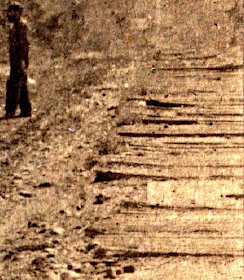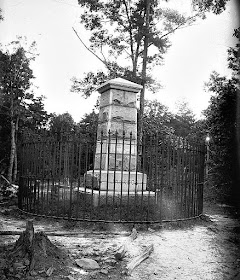 |
| Stonewall Jackson |
The caption on the April 1866 stereoview, the earliest known image of the Jackson wounding site, noted the general suffered his wounds to the left of the two men who appear at the center of the photo. Dr. Reed Bontecou, who led the expedition for the U.S. Army Medical Museum, is believed to be at the far left. (For more on Bontecou, see John Cummings' fine Spotsylvania Civil War blog here.)
In early November 2016, a private collector purchased this previously unknown Brown stereoview on eBay — the right half appears above. (How did I miss this on eBay?!!!) Note the plank road at the far right of the 1866 image.
On a mid-March afternoon, a certain Civil War blogger dodged traffic on ridiculously busy Route 3 — the war-time Orange Plank Road — to shoot a present-day view of the scene. The result is a representative but not spot-on "Now" photo. The shooting site, marked in 1888 by a monument near the Chancellorsville Battlefield Visitors' Center, is no longer visible to motorists who pass by.
Bob Zeller, president and co-founder of the Center for Civil War Photography, first reported the existence of Brown's Jackson wounding site image in the organization's Battlefield Photographer magazine. (Consider joining the CCWP. Full disclosure: I am secretary-treasurer.)
In early November 2016, a private collector purchased this previously unknown Brown stereoview on eBay — the right half appears above. (How did I miss this on eBay?!!!) Note the plank road at the far right of the 1866 image.
On a mid-March afternoon, a certain Civil War blogger dodged traffic on ridiculously busy Route 3 — the war-time Orange Plank Road — to shoot a present-day view of the scene. The result is a representative but not spot-on "Now" photo. The shooting site, marked in 1888 by a monument near the Chancellorsville Battlefield Visitors' Center, is no longer visible to motorists who pass by.
Bob Zeller, president and co-founder of the Center for Civil War Photography, first reported the existence of Brown's Jackson wounding site image in the organization's Battlefield Photographer magazine. (Consider joining the CCWP. Full disclosure: I am secretary-treasurer.)
Grab the slider to travel from the "Then" to "Now." For a large-format version of this Then & Now, visit my Civil War photo blog here. Below are more images of the site.
 |
| A cropped enlargement of Brown's image shows the planks on the old Orange Plank Road. |
 |
| Post-war image by George Oscar Brown of the Orange Plank Road and Mountain Road intersection. Jackson is believed to have been shot at the far right or farther down the road, out of view of the camera. (Library of Congress | CLICK ON IMAGE TO ENLARGE.) |
 |
| An 1890 painting of the Jackson wounding site. The monument was added in 1888. (Library of Congress) |
 |
| An early view of the Jackson wounding monument, date unknown. The monument is no longer surrounded by a fence. (Library of Congress) |
Those two photos are dead on, no funny stuff intended. I like the “paved" area to the right in the 1866 photo.
ReplyDeleteIs the Jackson wounding site being protected from the Maoists attempting to destroy all monuments to Confederates?
ReplyDeleteWhat's a Maoist?
DeleteThis comment has been removed by a blog administrator.
DeleteOne can only hope.
DeleteOne can only hope.
DeleteThe monument should be a testament to a traitorous murderer of American soldiers had to suffer for eight days in an example of divine and glorious intervention and we should all agree to preserve that history.
Delete"Traitorous murder" - very subjective. I think you lack a basic understanding of the reality of statehood at that time vs. the idea of a united nation. This was only a very few generations removed from the states trying to form a federal government (Articles of Confederation) in order to protect against foreign invasion. This was an attempt at a federal government with a bare minimum amount of power. The people of the time were very state-oriented and feared centralized power. It's very difficult to overstate these facts. The true identity of the United States, as we know it today, was forged in the aftermath of the civil war.
DeleteThis is one of the clearest explanations for anyone who doesnt understand "sectionalism" and the mindset of the United States leading up to the Civil War.
DeleteThank you for the pictures. I love looking at historical photos. Too many of these sites are gone.
ReplyDeleteThank you for sharing and for all of your pictures
ReplyDeleteGreat side by side pics. My great grandfather was with the 6th Alabama and wounded on the third day of battle.
ReplyDeleteYou need to view history thru the lens of time. Most people during the time immediately prior to the Civil War were very loyal to their home states. My family has been in Pennsylvania since the 1700s. Many still reside here. I imagine it was the same for Virginians. Yes, you can view Stonewall Jackson as a traitor but I think that is the easy answer. He may have shot at my ancestors but I still think a monument to him is appropriate. He had a huge impact on the Civil War. I am just glad he died before Gettysburg or the outcome may have been very different.
ReplyDeleteMy 82d Ohio ancestor was attacked by Jackson’s flank attack. He was lucky in not being captured, escaping by retreating to some wooded area as the Confederate attack dwindled in the darkness. He was later captured at Gettysburg and survived Andersonville—quite a story!
ReplyDeleteThese comments are taking up most of the pictures
ReplyDelete